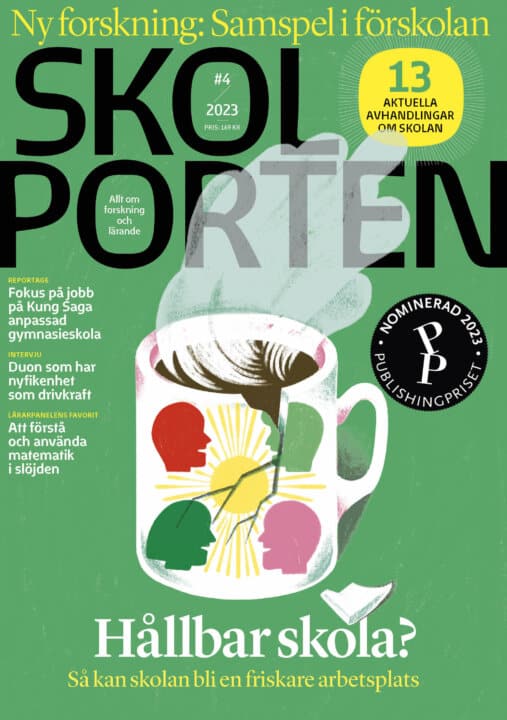Autism: educational outcomes and self-harm in adolescents and young adults
Isidora Stark har forskat om elever med autism utan intellektuell funktionsnedsättning i relation till utbildningsresultat och självskadebeteende.
Isidora Stark
Professor Cecilia Magnusson, Karolinska Institutet Associate Professor Dheera Rajj, Bristol Medical School Selma Idring Nordström, Karolinska Institutet
Docent Fotis Papadopoulos, Uppsala universitet
Karolinska Institutet
2022-12-16
Autism: educational outcomes and self-harm in adolescents and young adults
Autism: educational outcomes and self-harm in adolescents and young adults
Autism is one of the most prevalent neurodevelopmental conditions worldwide, and autistic individuals face challenges in daily functioning related to differences and difficulties in social interaction and communication along with intense interests and behaviours. In the past, this heterogenous and common condition was considered to be rare. Outcomes in education and mental ill-health are not fully understood in the more recent cohorts.
This thesis investigates two domains of outcomes in young autistic individuals: educational performance, focusing on compulsory/primary and upper secondary mainstream schooling in autistic students without intellectual disability in study I and study III; and self-harm behaviours including their characteristics and link with suicide in studies II and IV.
All four studies in this thesis are observational, prospective, register-based total-population cohort studies. Studies I-III utilize rich data collected in Stockholm Youth Cohort, a total population cohort of children aged 0 – 17 years resident in Stockholm County in Sweden, from 2001 to 2011 (N = 736,180). A range of national and regional records were linked using personal identification numbers that are assigned to every Swedish resident. In Study IV we linked the Total Population Register to four longitudinal, nationwide, registers in Sweden: The Multi-Generation Register, The Longitudinal Integration Database for Occupational research, and The Cause-of-Death Register, and identified study population of adolescents and younger adults born between 1984-2009. We follow-up this population (N = 2,822,789) until December 31st, 2021, when the oldest study participants were aged 37 years.
In Study I we observed a significantly lower proportion of autistic students (57 %; p < 0.05) meeting eligibility criteria for upper secondary education as compared to their non-autistic peers (86 %; p < 0.05). At the end of secondary mainstream school (Study III) autistic students were almost three times less likely to complete the school (OR 2.9 [95 % CI 2.70; 3.15]) compared to their non-autistic peers. In both studies females and students with co-occurring attention deficit hyperactivity disorder were at particularly high risks of adverse outcomes. Study II observed discrepancies between self-harm, sufficiently severe to lead to hospitalization: nearly 3 % of autistic individuals had been hospitalized at least once for self-harm between the ages of 10 and 27 years, compared with 0.8 % of their non-autistic peers. In study IV, autistic individuals with a record of self-harm were found to be at substantially higher risk of suicide (HR 22.9 95 % CI [19.5 – 26.9]) than both non-autistic self-harmers HR 16.2 95 % CI [14.9 – 17.5] and autistic individuals who did not engage in self-harm (HR 1.8 95 % CI [1.5 – 2.1]), as compared to non-autistic individuals without a record of self-harm.
The findings of this thesis suggest that autistic students without intellectual disability attending mainstream education in Stockholm (compulsory and upper secondary) are at a higher risk of low educational attainment in terms of formal requirements for continuation of schooling or work. Autistic females and students with co-occurring attention deficit hyperactivity disorder are particularly sensitive to this underachievement.
Autism was associated with increased risk of self-harm independently of comorbid ADHD, depression and anxiety disorders, and the likelihood of self-harm in autism was as high as in these conditions. Choice of methods used to self-harm by autistic, may be more lethal that those used by non-autistic individuals. Self-harm in autistic individuals conveys particularly increased risk of consecutive suicide, even more so than in non-autistic peers. Together, these findings indicate that self-harm which is an important predictor of suicide in the general population, should be a matter of great clinical concern if present in young autistic individuals, and that the needs of autistic self-harmers should be included in clinical guidelines and risk assessment processes.
Relaterade länkar

Undervisa i artificiell intelligens
 Gy–Vux
Gy–Vux 







